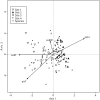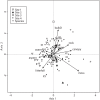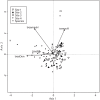Comparison of diversity and composition of macrofungal species between intensive mushroom harvesting and non-harvesting areas in Oaxaca, Mexico
- PMID: 31976170
- PMCID: PMC6967021
- DOI: 10.7717/peerj.8325
Comparison of diversity and composition of macrofungal species between intensive mushroom harvesting and non-harvesting areas in Oaxaca, Mexico
Abstract
Wild edible mushrooms have been collected and consumed by human groups for centuries, and today they represent a relevant source of food and income for many rural families worldwide. Preserving these non-timber forest products is of great interest, and there is concern about the damage caused by intensive mushroom harvesting on macromycete communities. The aim of this study was to evaluate variation in diversity and composition of macromycete species between areas regularly used for mushroom harvesting and non-harvested areas in the Mixteca region of Oaxaca, Mexico, as well as to assess the influence of microclimatic and environmental factors on this variation. We selected two harvested and two non-harvested sites within the study area. In each one, we established 10 permanent plots of 10 m × 10 m where we sampled all the observed fruit bodies weekly from June to October 2017. We recorded a total of 856 individuals corresponding to 138 species, and 23 of these were identified as edible. Overall macromycete diversity, edible species diversity and composition were similar in Sites 1 (non-harvested) and 3 (harvested), and in Sites 2 (non-harvested) and 4 (harvested). Variation of diversity and species composition along the studied area was mainly related to microclimatic variables, while most environmental variables and variables related to vegetation structure similarly affected macromycete species in the four sites. Our results indicate that intensive harvesting of wild edible mushrooms is not affecting the diversity and distribution of macromycete species in our study area. Knowledge on the sustainability of mushroom harvesting practices can help improve current regulations regarding the management of these valuable non-timber forest products.
Keywords: Distribution; Diversity; Edible mushrooms; Management; Non-timber forest product; Pine-oak forest.
© 2019 Ruiz-Almenara et al.
Conflict of interest statement
The authors declare that they have no competing interests.
Figures






Similar articles
-
Variation in traditional knowledge of culturally important macromycete species among three indigenous communities of Oaxaca, Mexico.J Ethnobiol Ethnomed. 2024 Mar 22;20(1):38. doi: 10.1186/s13002-024-00679-8. J Ethnobiol Ethnomed. 2024. PMID: 38519986 Free PMC article.
-
Impact of urbanization on functional diversity in macromycete communities along an urban ecosystem in Southwest Mexico.PeerJ. 2021 Sep 21;9:e12191. doi: 10.7717/peerj.12191. eCollection 2021. PeerJ. 2021. PMID: 34616630 Free PMC article.
-
Traditional knowledge and use of wild mushrooms by Mixtecs or Ñuu savi, the people of the rain, from Southeastern Mexico.J Ethnobiol Ethnomed. 2016 Sep 5;12(1):35. doi: 10.1186/s13002-016-0108-9. J Ethnobiol Ethnomed. 2016. PMID: 27595599 Free PMC article.
-
Mushroom hunting and consumption in twenty-first century post-industrial Sweden.J Ethnobiol Ethnomed. 2019 Aug 19;15(1):42. doi: 10.1186/s13002-019-0318-z. J Ethnobiol Ethnomed. 2019. PMID: 31426821 Free PMC article. Review.
-
Selenium in edible mushrooms.J Environ Sci Health C Environ Carcinog Ecotoxicol Rev. 2008 Jul-Sep;26(3):256-99. doi: 10.1080/10590500802350086. J Environ Sci Health C Environ Carcinog Ecotoxicol Rev. 2008. PMID: 18781538 Review.
Cited by
-
Green trees preservation: A sustainable source of valuable mushrooms for Ethiopian local communities.PLoS One. 2023 Nov 29;18(11):e0294633. doi: 10.1371/journal.pone.0294633. eCollection 2023. PLoS One. 2023. PMID: 38019803 Free PMC article.
-
Diversity Patterns of Macrofungi in Xerothermic Grasslands from the Nida Basin (Małopolska Upland, Southern Poland): A Case Study.Biology (Basel). 2022 Mar 30;11(4):531. doi: 10.3390/biology11040531. Biology (Basel). 2022. PMID: 35453729 Free PMC article.
-
Mushroom and Kefir Functional Characterizations: Hypolipidemia and Gut Microbiota Modulations in Rat Models.Food Sci Nutr. 2024 Oct 31;12(12):10181-10193. doi: 10.1002/fsn3.4503. eCollection 2024 Dec. Food Sci Nutr. 2024. PMID: 39723083 Free PMC article.
-
Variation in traditional knowledge of culturally important macromycete species among three indigenous communities of Oaxaca, Mexico.J Ethnobiol Ethnomed. 2024 Mar 22;20(1):38. doi: 10.1186/s13002-024-00679-8. J Ethnobiol Ethnomed. 2024. PMID: 38519986 Free PMC article.
-
Metabarcoding analysis of the soil fungal community to aid the conservation of underexplored church forests in Ethiopia.Sci Rep. 2022 Mar 21;12(1):4817. doi: 10.1038/s41598-022-08828-3. Sci Rep. 2022. PMID: 35314738 Free PMC article.
References
-
- Arnolds E. Conservation and management of natural populations of edible fungi. Canadian Journal of Botany. 1995;73(S1):987–998. doi: 10.1139/b95-349. - DOI
-
- Benítez-Badillo G, Alvarado-Castillo G, Nava-Tablada M, Pérez-Vázquez A. Análisis del marco regulatorio en el aprovechamiento de los hongos silvestres comestibles en México. Revista Chapingo. Serie Ciencias Forestales y del Ambiente. 2013;19(3):363–374. doi: 10.5154/r.rchscfa.2012.09.055. - DOI
-
- Boa E. Wild edible fungi: a global overview of their use and importance to people. Rome: Food and Agriculture Organization of the United Nations; 2004.
-
- Brown N, Bhagwat S, Watkinson S. Macrofungal diversity in fragmented and disturbed forests of the Western Ghats of India. Journal of Applied Ecology. 2006;43(1):11–17. doi: 10.1111/j.1365-2664.2005.01107.x. - DOI
-
- Caiafa MV, Gómez-Hernández M, Williams-Linera G, Ramírez-Cruz V. Functional diversity of macromycete communities along an environmental gradient in a Mexican seasonally dry tropical forest. Fungal Ecology. 2017;28:66–75. doi: 10.1016/j.funeco.2017.04.005. - DOI
LinkOut - more resources
Full Text Sources

